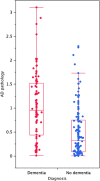Cognitive reserve, presynaptic proteins and dementia in the elderly
- PMID: 22832958
- PMCID: PMC3365257
- DOI: 10.1038/tp.2012.38
Cognitive reserve, presynaptic proteins and dementia in the elderly
Abstract
Differences in cognitive reserve may contribute to the wide range of likelihood of dementia in people with similar amounts of age-related neuropathology. The amounts and interactions of presynaptic proteins could be molecular components of cognitive reserve, contributing resistance to the expression of pathology as cognitive impairment. We carried out a prospective study with yearly assessments of N = 253 participants without dementia at study entry. Six distinct presynaptic proteins, and the protein-protein interaction between synaptosomal-associated protein 25 (SNAP-25) and syntaxin, were measured in post-mortem brains. We assessed the contributions of Alzheimer's disease (AD) pathology, cerebral infarcts and presynaptic proteins to odds of dementia, level of cognitive function and cortical atrophy. Clinical dementia was present in N = 97 (38.3%), a pathologic diagnosis of AD in N = 142 (56.1%) and cerebral infarcts in N = 77 (30.4%). After accounting for AD pathology and infarcts, greater amounts of vesicle-associated membrane protein, complexins I and II and the SNAP-25/syntaxin interaction were associated with lower odds of dementia (odds ratio = 0.36-0.68, P < 0.001 to P = 0.03) and better cognitive function (P < 0.001 to P = 0.03). Greater cortical atrophy, a putative dementia biomarker, was not associated with AD pathology, but was associated with lower complexin-II (P = 0.01) and lower SNAP-25/syntaxin interaction (P < 0.001). In conclusion, greater amounts of specific presynaptic proteins and distinct protein-protein interactions may be structural or functional components of cognitive reserve that reduce the risk of dementia with aging.
Figures




References
-
- Selkoe DJ. Alzheimer's disease is a synaptic failure. Science. 2002;298:789–791. - PubMed
-
- Washbourne P, Thompson PM, Carta M, Costa ET, Mathews JR, Lopez-Benditó G, et al. Genetic ablation of the t-SNARE SNAP-25 distinguishes mechanisms of neuroexocytosis. Nat Neurosci. 2002;5:19–26. - PubMed
-
- Glynn D, Bortnick RA, Morton AJ. Complexin II is essential for normal neurological function in mice. Hum Mol Genet. 2003;12:2431–2448. - PubMed
-
- Drew CJ, Kyd RJ, Morton AJ. Complexin 1 knockout mice exhibit marked deficits in social behaviours but appear to be cognitively normal. Hum Mol Genet. 2007;16:2288–2305. - PubMed
Publication types
MeSH terms
Substances
Grants and funding
LinkOut - more resources
Full Text Sources
Other Literature Sources
Medical

